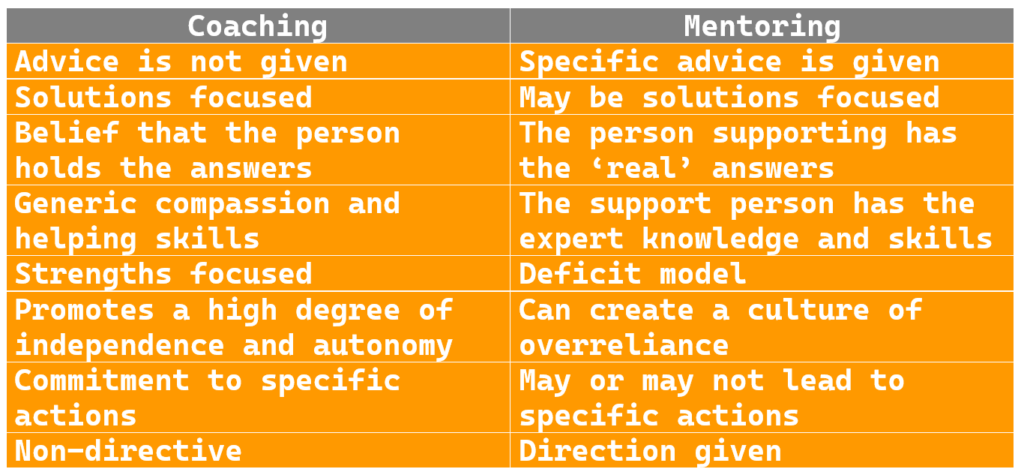More and more in education, we are seeing the term coaching being applied to cover all manner of working relationships. Understanding the nuanced differences between coaching and mentoring is crucial, particularly for leaders operating at an executive level. This article aims to clarify these distinctions, offering a comprehensive evaluation of the relative merits of both disciplines. Furthermore, it will emphasise the significance of coaching as a powerful tool that can thoroughly benefit executive and senior leaders.
Understanding Coaching: A Conversation with Impact
At its core, coaching is a conversation or a series of conversations that one person has with another. However, what differentiates coaching from ordinary dialogue is the profound impact it has on the coachee (the person being coached). As Starr (2016) succinctly puts it, “An effective coaching conversation influences someone’s understanding, learning, behaviour, and progress.”
Coaching is about unlocking a person’s potential by removing the internal barriers that prevent them from achieving their best. This concept, extensively discussed by Gallwey (2000) in his work on the Inner Games, emphasises the importance of enabling individuals to reach their full potential. Sir John Whitmore (2017) echoes this sentiment, describing coaching as “Unlocking people’s potential to maximise their own performance.”
In its purest form, coaching is entirely non-directive. The coach does not offer advice but instead holds a genuine belief that the coachee already possesses all the answers they need. This approach fosters a strengths-focused model that promotes independence and self-reliance.
Imagine an organisation filled with individuals who believe in their ability to find solutions, equipped with the skills to bring those solutions to the surface through skilful questioning. In such a scenario, executive leaders would spend less time solving problems that fall beyond their remit and more time engaging in strategic thinking and decision-making. Coaching not only empowers staff at all levels but also facilitates higher-level thinking, crucial for solving minor crises efficiently.
Another key advantage of coaching is the autonomy it promotes. The coachee gains insight into the solutions they need, rather than having answers dictated to them, reducing the likelihood of conflict or disagreement. Moreover, research shows that autonomy is a significant factor in job satisfaction, motivation, and productivity.
The Flexibility of Coaching in Leadership
A notable benefit of coaching is its flexibility. Senior leaders and executives can be coached by individuals with equal or even less experience or expertise. This flexibility extends to the possibility of coaching one’s superiors. Interestingly, being coached by a superior might actually reduce the effectiveness of the process, as the coachee may feel compelled to seek the answer they think their manager wants to hear, rather than trusting their instincts.
This non-hierarchical nature of coaching is highly practical, as it opens up the potential for a greater number of people to support each other within an organisation. Unlike traditional top-down support models, where the capacity for support is limited by hierarchical ratios (e.g., executives to managers, managers to supervisors), coaching allows for many more developmental relationships across all levels.
Mentoring: A Deficit Model with a Different Focus
In contrast, mentoring is often based on a deficit model, where one person (the mentor) is the expert, and the other (the mentee) takes on an apprentice role, learning from their more skilled superior. For senior leaders, who are accustomed to a high degree of autonomy, this imbalance of power in the mentor-mentee relationship can be uncomfortable.
In an executive mentoring session, explicit advice is typically given by the mentor, presupposing that the mentor holds the correct answers and the majority of expert knowledge. However, this approach can be limiting. Mentoring may come across as judgmental and can lead to overdependence on the mentor. At the executive level, where a leader may have numerous staff members to manage, it is neither efficient nor effective to position oneself as the sole oracle of knowledge.
Michael Bungay Stanier (2020) warns against falling into “The Advice Trap,” where leaders create an overdependent team, become overwhelmed by their workload, and disconnect from the meaningful, impactful work that truly matters.
The Role of Mentoring in Specific Contexts
However, when done skilfully, mentoring can be solutions-focused and yield specific actions similar to coaching. Instructional coaching, a soft form of coaching, combines the beneficial aspects of both coaching and mentoring to support less-experienced colleagues. We see this in the Early Career Framework to support ECTs.
Mentoring is particularly valuable in situations where the individual being supported lacks the necessary knowledge to independently find solutions. This requires a more directive, transmission-based model. For instance, in an educational setting, compliance with health and safety protocols or child protection procedures necessitates a mentoring approach. Here, the focus is on ensuring that specific processes are followed accurately, making a coaching model less effective.

Conclusion: Embracing Coaching for Executive Development
While both coaching and mentoring have their places within an organisation, there are significant advantages of adopting a coaching approach. This does not need to be through formal coaching sessions. Gains can also be seen when leaders undertake rudimentary training and just become more coach-like in their approach. By fostering a culture of autonomy, independence, and problem solving, coaching creates sustainable improvements in organisation and empowers senior leaders and executives to focus on high-level decision-making and innovation. At the very least, you will have fewer knocks on your door and emails clogging up your inbox!
If you would like to start a conversation about how coaching could transform your leadership and organisation, visit our website and fill in a contact form.
References:
- Gallwey, T (2000). The Inner Game of Work, Texere
- Stanier, M. B. (2020). The Advice Trap. Toronto Box of Crayons Press.
- Starr, J. (2016). The coaching manual: the definitive guide to the process, principles, and skills of personal coaching. Fourth ed. Harlow, Royaume-Unis: Pearson Education.
- Whitmore, J. (2017). Coaching for performance: GROWing human potential and purpose: the principles and practice of coaching and leadership. 5th ed. London: Nicholas Brealey.

